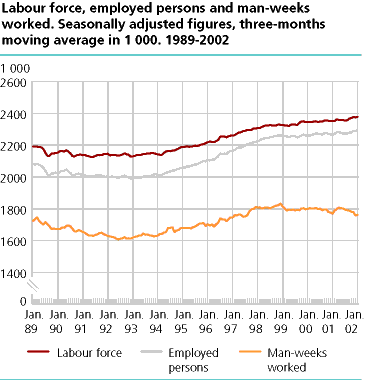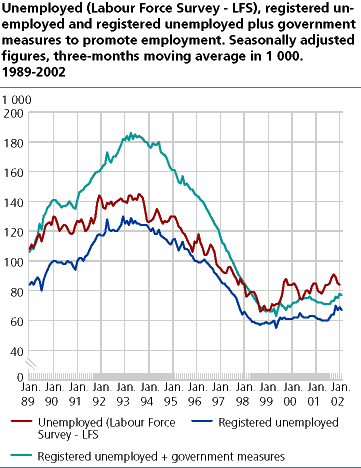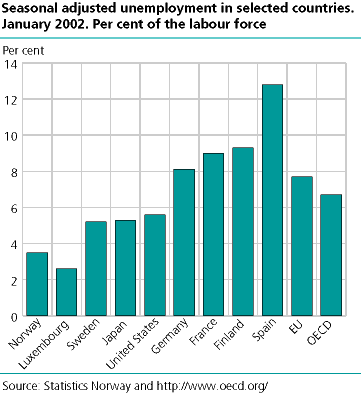Content
Published:
This is an archived release.
Stable labour market
Seasonally adjusted figures from the Labour Force Survey (LFS) indicate a weak increase in employment and a slight decrease in unemployment.
Seasonally adjusted figures indicate an increase in employment of 15 000 persons from September - November last year to December - February this year. The increase is larger than the error margins for the change in figures, but an unusually low value of the September 2001 observation caused a considerable portion of the increase. In the same period the number of unemployed persons decreased by 7 000. In per cent of the labour force the number of unemployed persons decreased by 0.3 percentage points, which is about the size of error margins for the change in figures. On other hand the seasonally adjusted figures the last couple of months for registered unemployed at the Employment Offices do not indicate the same tendency.
A total of 2 275 000 persons were employed and 78 000 persons were unemployed in the fourth quarter of 2001 according to figures from the LFS, not seasonally adjusted.
Unemployment in EU and OECD: 7.7 and 6.7 per cent
The OECD-area unemployment rate on a standardized basis was 6.7 per cent in January this year, 0.2 percentage points higher than in December last year. In the European Union the unemployment rate remained stable at 7.7 per cent in January. The unemployment rate in the United States was 5.5 per cent in February this year, down by 0.1 percentage points since January, but up by 1.3 percentage points since February last year. In Sweden the unemployment rate rose from 5.1 per cent in December last year to 5.2 per cent in January this year. In the same period the unemployment rate rose to 8.1 per cent in Germany and to 9.0 per cent in France. The unemployment rate remained stable at 9.3 per cent in Finland, and at 12.8 per cent in Spain. In Japan the unemployment rate fell to 5.3 per cent.
Man-weeks worked
The number of man-weeks worked decreased by 19 000 from September - November last year to December - February. The increase is probably within the error margins for these figures.
Previous to the seasonal adjustment, we also make adjustments for holidays that fall in random months every year. This year part of the country had winter holiday during one of the last two weeks of February. Due to this fact we adjust the figure of man-weeks worked up by 83 000 prior to the seasonal adjustment. The adjustments are made so that the relative change in average weekly working hours from November 2001 to February this year is the same as in the previous year.
The purpose of adjusting for seasonal variations is to describe the development during the last year and to give figures for change between the last two 3-month periods, cleared for normal seasonal variations. In order to reduce uncertainty, the presented series are three months moving averages of the seasonally adjusted figures. For instance the figure from January is the average of the estimates from December, January and February.
Tables:
The statistics is published with Labour force survey.
Contact
-
Arbeidsmarked og lønn
E-mail: arbeidsmarked@ssb.no
-
Erik Herstad Horgen
E-mail: erik.horgen@ssb.no
tel.: (+47) 93 08 68 62



